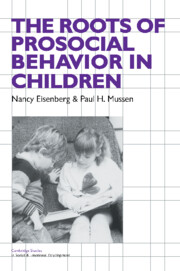Book contents
- Frontmatter
- Contents
- Preface
- 1 Introduction
- 2 Methodological and theoretical considerations in the study of prosocial behavior
- 3 Biology and prosocial behavior
- 4 Culture and prosocial behavior
- 5 “Person” variables and prosocial behavior
- 6 Socialization in the family
- 7 Socialization by agents outside the family
- 8 Cognition, role taking, interpersonal problem solving, and moral judgment
- 9 Emotional factors in prosocial behavior
- 10 Situational determinants
- 11 Conclusions
- References
- Name index
- Subject index
6 - Socialization in the family
Published online by Cambridge University Press: 31 December 2009
- Frontmatter
- Contents
- Preface
- 1 Introduction
- 2 Methodological and theoretical considerations in the study of prosocial behavior
- 3 Biology and prosocial behavior
- 4 Culture and prosocial behavior
- 5 “Person” variables and prosocial behavior
- 6 Socialization in the family
- 7 Socialization by agents outside the family
- 8 Cognition, role taking, interpersonal problem solving, and moral judgment
- 9 Emotional factors in prosocial behavior
- 10 Situational determinants
- 11 Conclusions
- References
- Name index
- Subject index
Summary
As we have seen, children generally acquire the patterns of behavior, motives, personal characteristics, predispositions, values, and social responses that are adaptive and expected in their own cultures. Most children reared in Mexican villages, Hopi children on reservations in the Southwest, and youngsters on Israeli kibbutzim are more considerate, kind, and cooperative than their “typical” middle-class American counterparts.
Nevertheless, cultural factors alone cannot account for the wide range of prosocial actions within each culture; some children are consistently cooperative and generous, but others are not. These individual differences are attributable primarily to variations in the ways children are socialized in their own families, where they acquire many of their personal attributes, motives, and values.
Many agents contribute to the child's socialization and to the development of prosocial tendencies. In the early years, the family is the principal agent of socialization. In this chapter, attention is centered on how the family promotes (or inhibits) prosocial behavior and, most important, strengthens (or weakens) children's internalized motivations for altruism, helpfulness, generosity, and consideration of others.
Socialization involves many processes. Parents often self-consciously attempt to teach their children prosocial responses by praising and approving altruism and generosity and punishing selfish and uncooperative responses. They may instruct their children, reason with them, and explain rules or standards of prosocial behavior. But many of the child's prosocial actions and motivations are the products of more subtle processes, such as imitation or identification; these responses appear to emerge spontaneously, without direct training or reward - usually without anyone intending to “teach” and without the child intending to learn.
- Type
- Chapter
- Information
- The Roots of Prosocial Behavior in Children , pp. 66 - 94Publisher: Cambridge University PressPrint publication year: 1989



